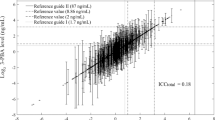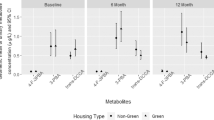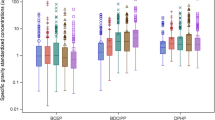Abstract
Despite the widespread use of synthetic pyrethroid insecticides that led to common exposure in the population, very few studies have been conducted to quantitatively assess human, particularly, children's, long-term exposures to pyrethroid insecticides. The objective of the Children Pesticide Exposure Study – Washington (CPES-WA) was to establish the longitudinal exposure profiles for pyrethroid insecticides in a cohort of children living in an urban and suburban community using urinary pyrethroid metabolites as exposure biomarkers. The results from this analysis will allow us to examine potential risk factors in relation to the elevated pyrethroid insecticide exposure in children. A total of 23 children, aged 3–11 years, who only consumed conventional diets were enrolled in this 1-year study. We provided organic food items to children for 5 consecutive days in the summer and fall sampling seasons. We measured urinary metabolites for the synthetic pyrethroid insecticides in urine samples that were collected twice daily during each of the four sampling seasons. 3-phenoxybenzoic acid was frequently detected in the urine samples with mean and median daily volume-weighted average levels of 1.5 and 1.2 μg/l, followed by trans-2,2-(dichloro)-2-dimethylvinylcyclopropane carboxylic acid (1.4 and 1.0 μg/l) and cis-2,2-(dichloro)-2-dimethylvinylcyclopropane carboxylic acid (0.5 μg/l, and non-detected). When we took into account season, age, sex, diet, and self-reported residential use of pyrethroid insecticides in a linear mixed-effects model, the results suggested that the combination of the use of pyrethroid insecticides in the household, dietary intake, and seasonal differences play a significant role in predicting children's exposure to synthetic pyrethroid insecticides. We found CPES-WA children were continuously exposed to pyrethroid insecticides through their diets all year long, and this chronic exposure pattern was periodically modified by episodes of relatively high exposures from residential uses. Future research should be devoted to enhancing our understanding of the complexity of pyrethroid insecticide exposure patterns.
This is a preview of subscription content, access via your institution
Access options
Subscribe to this journal
Receive 6 print issues and online access
$259.00 per year
only $43.17 per issue
Buy this article
- Purchase on Springer Link
- Instant access to full article PDF
Prices may be subject to local taxes which are calculated during checkout


Similar content being viewed by others
Abbreviations
- ATSDR:
-
Agency for Toxic Substances and Diseases Registry
- CDC:
-
Center for Disease Control and Prevention
- CPES:
-
Children's Pesticide Exposure Study
- CPES-WA:
-
Children's Pesticide Exposure Study – Washington
- CPES-GA:
-
Children's Pesticide Exposure Study – Georgia
- DBCA:
-
cis-2,2-(dibromo)-2-dimethylvinylcyclopropane carboxylic acid
- cis-DCCA:
-
cis-2,2-(dichloro)-2-dimethylvinylcyclopropane carboxylic acid
- trans-DCCA:
-
trans-2,2-(dichloro)-2-dimethylvinylcyclopropane carboxylic acid
- DVWA concentration:
-
daily volume-weighted average concentration
- FPBA:
-
4-fluoro-3-phenoxybenzoic acid
- FQPA:
-
Food Quality Protection Act
- LOD:
-
limit of detection
- NHANES:
-
National Human Nutrition and Health Survey
- OP:
-
organophosphorus pesticide
- PBA:
-
3-phenoxybenzoic acid; US EPA United States Environmental Protection Agency
References
Agency for Toxic Substances and Disease Registry. Toxicological profile for pyrethrins and pyrethroids, 2003. Available at: http://www.atsdr.cdc.gov/toxprofiles/tp155.html accessed October 11, 2007.
Becker K., Seiwert M., Angerer J., Kolossa-Gehring M., Hoppe H.W., Ball M., et al. IV GerES Pilot Study: assessment of the exposure of German children to organophosphorus and pyrethroid pesticides. Int J Hyg Environm Health 2006: 209 (3): 221–233.
Centers for Disease Control. The Center for Disease Control and Prevention 2001–2002 National Health and Nutrition Examination Survey (NHANES). National Center for Health Statistics, 2005. available at: http://www.cdc.gov/nchs/about/major/nhanes/datalink.htm accessed September 10, 2007.
Chen H.Y., Xiao J.G., Hu G., Zhou J.W., Xiao H., and Wang X.R. Estrogenicity of organophosphorus and pyrethroid pesticides. J Toxicol Environ Health A 2002: 65 (19): 1419–1435.
Hardt J., and Angerer J. Biological monitoring of workers after the application of insecticidal pyrethroids. Int Arch Occup Environ Health 2003: 76 (7): 492–498.
Heudorf U., and Angerer J. Metabolites of pyrethroid insecticides in urine specimens: current exposure in an urban population in Germany. Environ Health Perspect 2001: 109 (3): 213–217.
Kakko I., Toimela T., and Tahti H. Oestradiol potentiates the effects of certain pyrethroid compounds in the MCF7 human breast carcinoma cell line. Altern Lab Anim 2004: 32 (4): 383–390.
Kim S.S., Lee R.D., Lim K.J., Kwack S.J., Rhee G.S., Seok J.H., et al. Potential estrogenic and antiandrogenic effects of permethrin in rats. J Reprod Dev 2005: 51 (2): 201–210.
Kuhn K.H., Wieseler B., Leng G., and Idel H. Toxicokinetics of pyrethroids in humans: consequences for biological monitoring. Bull Environ Contam Toxicol 1999: 62 (2): 101–108.
Kunimatsu T., Yamada T., Ose K., Sunami O., Kamita Y., Okuno Y., Seki T., and Nakatsuka I. Lack of (anti-) androgenic or estrogenic effects of three pyrethorids (esfenvalerate, fenvalerate, and permethrin) in the Hershberger and uterotrophic assays. Regul Toxicol Pharmacol 2002: 35: 227–237.
Leng G., Leng A., Kuhn K.H., Lewalter J., and Pauluhn J. Human dose-excretion studies with the pyrethroid insecticide cyfluthrin: urinary metabolite profile following inhalation. Xenobiotica 1997: 27 (12): 1273–1283.
Leng G., Ranft U., Sugiri D., Hadnagy W., Berger-Preiss E., and Idel H. Pyrethroids used indoors – biological monitoring of exposure to pyrethroids following an indoor pest control operation. Int J Hyg Environ Health 2003: 206 (2): 85–92.
Lothrop H., Lothrop B., Palmer M., Wheeler S., Gutierrez A., Gomsi D., et al. Evaluation of pyrethrin and permethrin ground ultra-low volume applications for adult Culex control in rural and urban environments of the Coachella Valley of California. J Am Mosq Control Assoc 2007: 23 (2): 190–207.
Lu C.S., Barr D.B., Pearson M., Bartell S., and Bravo R. A longitudinal approach to assessing urban and suburban children's exposure to pyrethroid pesticides. Environ Health Perspect 2006: 114 (9): 1419–1423.
Lu C., Barr D.B., Pearson M.A., and Waller L.A. Dietary intake and its contribution to longitudinal organophosphorus pesticide exposure in urban/suburban children. Environ Health Perspect 2008: 116 (4): 537–542.
Lu C.S., Knutson D.E., Fisker-Andersen J., and Fenske R.A. Biological monitoring survey of organophosphorus pesticide exposure among preschool children in the Seattle metropolitan area. Environ Health Perspect 2001: 109 (3): 299–303.
Lu C.S., Toepel K., Irish R., Fenske R.A., Barr D.B., and Bravo R. Organic diets significantly lower children's dietary exposure to organophosphorus pesticides. Environ Health Perspect 2006: 114 (2): 260–263.
Morgan M.K., Sheldon L.S., Croghan C.W., Jones P.A., Chuang J.C., and Wilson N.K. An observational study of 127 preschool children at their homes and daycare centers in Ohio: environmental pathways to cis- and trans-permethrin exposure. Environ Res 2007: 104 (2): 266–274.
Olsson A.O., Baker S.E., Nguyen J.V., Romanoff L.C., Udunka S.O., Walker R.D., et al. A liquid chromatography-tandem mass spectrometry multiresidue method for quantification of specific metabolites of organophosphorus pesticides, synthetic pyrethroids, selected herbicides, and DEET in human urine. Anal Chem 2004: 76 (9): 2453–2461.
Ortiz-Perez M.D., Torres-Dosal A., Batres L.E., Lopez-Guzman O.D., Grimaldo M., Carranza C., et al. Environmental health assessment of deltamethrin in a malarious area of Mexico: environmental persistence, toxicokinetics, and genotoxicity in exposed children. Environ Health Perspect 2005: 113 (6): 782–786.
Presibella K.M., Kita D.H., Carneiro C.B., Andrade A.J., and Dalsenter P.R. Reproductive evaluation of two pesticides combined (deltamethrin and endosulfan) in female rats. Reprod Toxicol 2005: 20 (1): 95–101.
Repetto R., and Baliga S.S. Pesticides and the immune system: the public health risks. Executive summary. Cent Eur J Public Health 1996: 4 (4): 263–265.
Samsam T.E., Hunter D.L., and Bushnell P.J. Effects of chronic dietary and repeated acute exposure to chlorpyrifos on learning and sustained attention in rats. Toxicol Sci 2005: 87 (2): 460–468.
Schettgen T., Heudorf U., Drexler H., and Angerer E. Pyrethroid exposure of the general population – is this due to diet? Toxicol Lett 2002: 134 (1–3): 141–145.
Shafer T.J., Meyer D.A., and Crofton K.M. Developmental neurotoxicity of pyrethroid insecticides: critical review and future research needs. Environ Health Perspect 2005: 113 (2): 123–136.
Tulve N.S., Egeghy P.P., Fortmann R.C., Whitaker D.A., Nishioka M.G., Naeher L.P., et al. Multimedia measurements and activity patterns in an observational pilot study of nine young children. J Expos Sci Environ Epidemiol 2007: 18 (1): 31–44.
US Environmental Protection Agency. Peer review of permethrin. Memo from Esther Rinde, Health Effects Division, to George LaRocca, Registration Division, Office of Pesticides and Toxic Substances, Washington DC, US Environmental Protection Agency, 1989.
US Environmental Protection Agency. Children's vulnerability to toxic substances in the environment. EPA600/F/98/013 1998. Available at: http://es.epa.gov/ncer/rfa/pdf/dchild.pdf accessed 14 January 2008.
US Environmental Protection Agency. Synthetic pyrethroids for insect control, 2005. Available at: http://www.epa.gov/pesticides/factsheets/pyrethroids4mosquitos.htm#pyrethroids accessed 11 October 2007.
US Environmental Protection Agency. Measuring the impact of the Food Quality Protection Act: challenges and opportunities. 2006-P-00028 2006. Available at: http://www.epa.gov/oig/reports/2006/20060801-2006-P-00028.pdf accessed 15 November 2007.
US Food and Drug Administration. Food Quality Protection Act, 1996. Available at: http://www.fda.gov/opacom/laws/foodqual/fqpatoc.htm accessed 11 October 2007.
Acknowledgements
This study was supported by the US Environmental Protection Agency, Science to Achieve Results program (RD-829364) and the National Center for Environmental Health in the Centers for Disease Control and Prevention, Atlanta, GA. Its contents are solely the responsibility of the authors and do not necessarily represent the official view of US EPA or CDC. We express our sincere appreciation to the children who participated and to their parents who greatly assisted in this study. We also thank Rene Irish, Kathryn Toepel, Patrick Sande, and Richard Fenske at the University of Washington, Seattle, WA, for their assistance in conducting this study, and Paula Restrepo, Jessica Norrgran, Robert Walker, and Charles Chambers at the NCEH/CDC for their help with sample analysis and data management.
Author information
Authors and Affiliations
Corresponding author
Additional information
Conflict of interest
The authors declare no competing financial interests.
Rights and permissions
About this article
Cite this article
Lu, C., Barr, D., Pearson, M. et al. The attribution of urban and suburban children's exposure to synthetic pyrethroid insecticides: a longitudinal assessment. J Expo Sci Environ Epidemiol 19, 69–78 (2009). https://doi.org/10.1038/jes.2008.49
Received:
Accepted:
Published:
Issue Date:
DOI: https://doi.org/10.1038/jes.2008.49
Keywords
This article is cited by
-
Comparison of questionnaire-based estimation of pesticide residue intake from fruits and vegetables with urinary concentrations of pesticide biomarkers
Journal of Exposure Science & Environmental Epidemiology (2018)
-
Oral exposure of deltamethrin and/or lipopolysaccharide (LPS) induced activation of the pulmonary immune system in Swiss albino mice
Environmental Science and Pollution Research (2018)
-
Toxicity of the pyrethroid bifenthrin insecticide
Environmental Chemistry Letters (2018)
-
Increasing Use of Pyrethroids in Canadian Households: Should We Be Concerned?
Canadian Journal of Public Health (2012)
-
Influences on transfer of selected synthetic pyrethroids from treated Formica to foods
Journal of Exposure Science & Environmental Epidemiology (2011)



